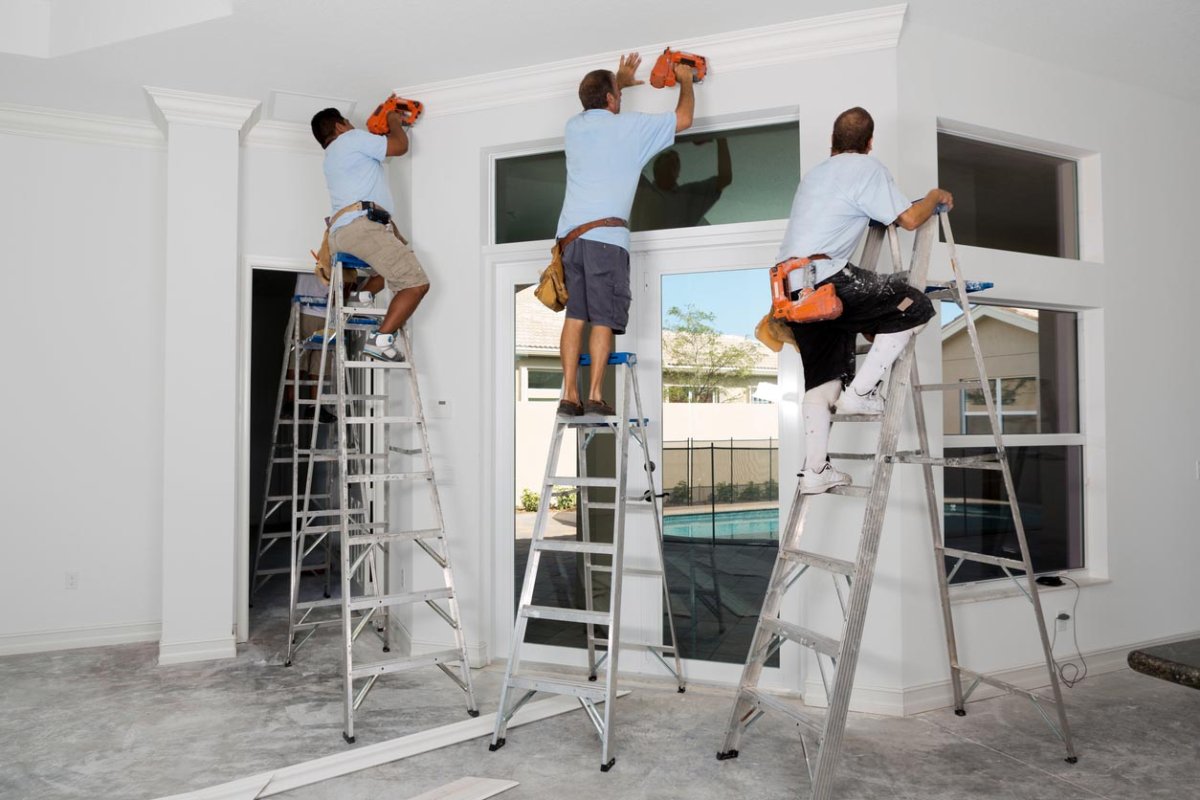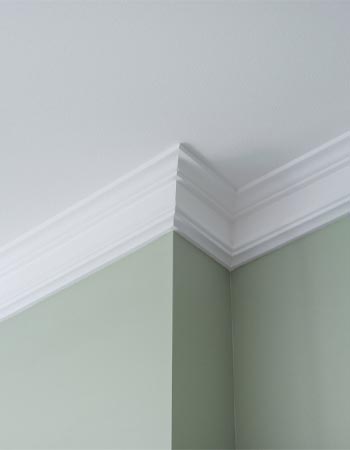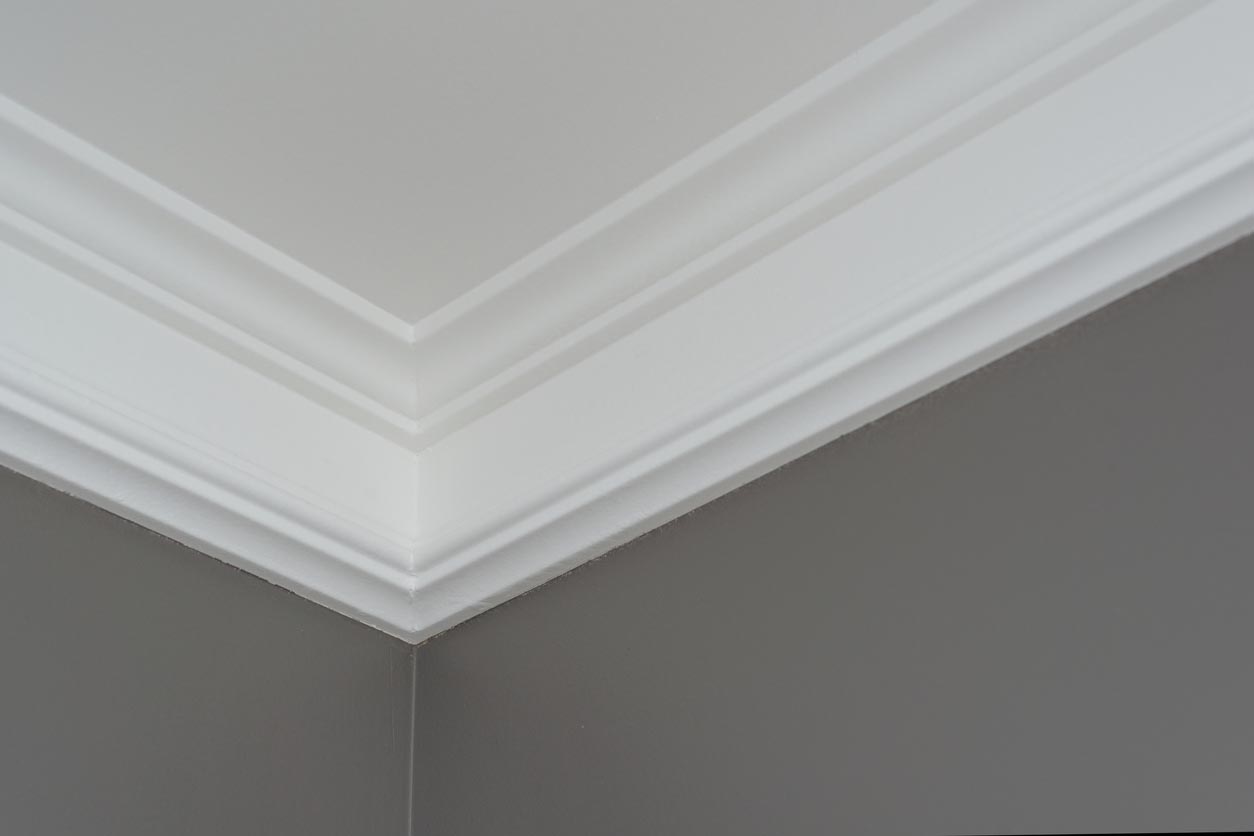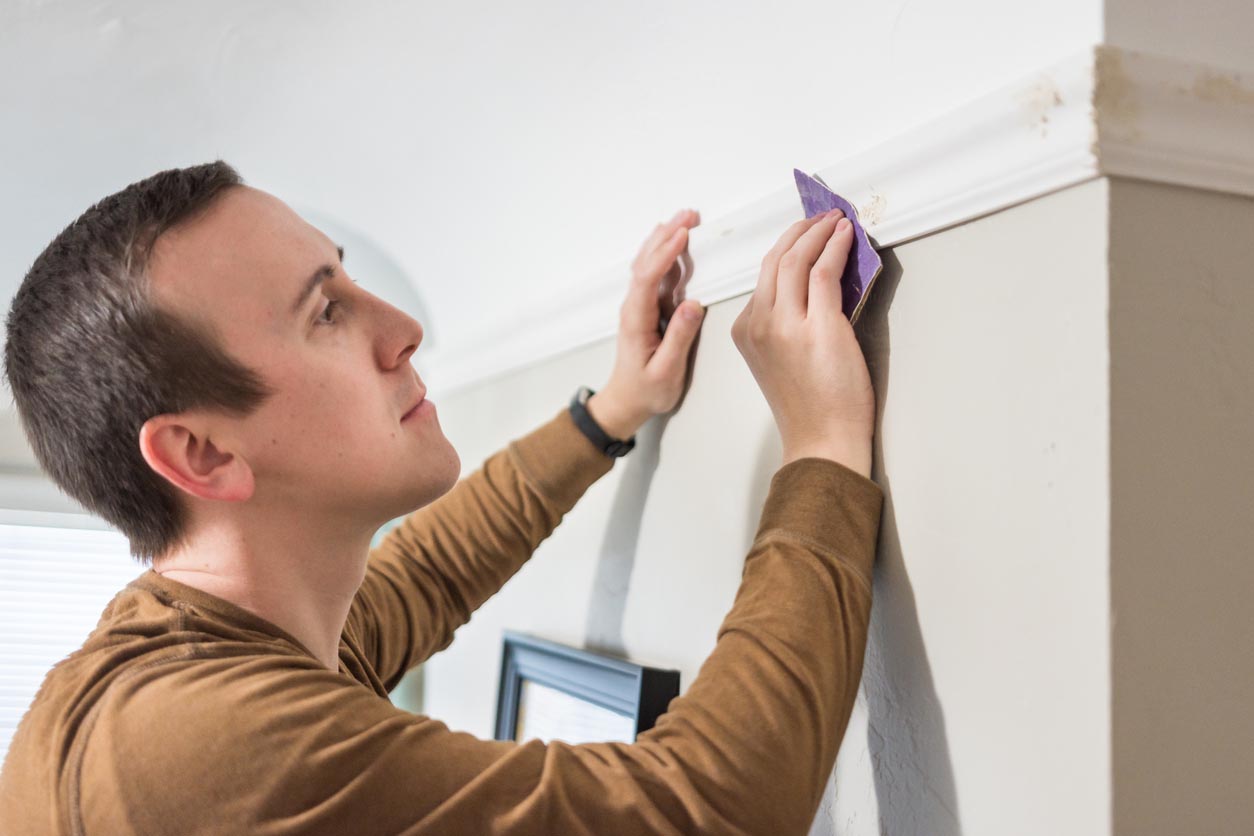

We may earn revenue from the products available on this page and participate in affiliate programs. Learn More ›
- Typical Range: $567 to $1,870
- National Average: $1,218
Crown molding (also spelled “moulding”) is like icing on the cake: It adds a decorative finished look that enhances a room. It can also serve as camouflage for cracks or an inferior taping job. In general, crown molding describes horizontal trim installed where the wall meets the ceiling, but true crown molding consists of trim boards installed at an angle between wall and ceiling.
A wide array of crown molding styles are available, from plain trim to elaborate moldings extending a foot down the wall, such as the type seen in federal buildings and courthouses. Most crown molding in homes falls somewhere between the two. It ranges in cost from $567 to $1,870, depending on material type and complexity. Most homeowners can expect to pay in the neighborhood of $1,218 for the cost to install crown molding throughout the home.
Factors in Calculating Cost to Install Crown Molding
Among the significant factors that go into calculating crown molding installation cost are the going rate of finish carpentry in the region, the type of material used for the crown molding, and the project’s complexity. The number of rooms also plays a role in figuring the cost. In most cases, homeowners opt to have the trim installed by an experienced finish carpenter. This is a specialized branch of carpentry because it requires finesse and skill.
Labor and Materials

In general, having crown molding installed will run $4 to $15 per linear foot, including labor charges and material costs. However, labor charges could go higher if the carpenter travels outside their service region. Other factors that can impact labor charges include the ceiling height: Installing crown molding in rooms with standard 9-foot ceilings won’t cost as much as installing the trim in a vaulted foyer with an 18-foot ceiling. While the per-foot cost to install molding gives you an idea of the final price, most finish carpenters charge by the hour, and their fees range from $50 to $100 per hour.
For centuries, wood and plaster were the materials of choice for crown molding. Artisans would craft complex molds and pour elaborate plaster crown moldings to install in cathedrals and other European structures. Today, many more types of crown molding are available for installation in homes, and the material chosen is a significant factor in the final cost.
- Wood: A wide variety of wood species can be used for crown molding, depending on the look the homeowner is going for. Expect to pay between $5 and $45 per linear foot.
- Plaster: While plaster is less common in today’s homes, it’s still used to create custom trim designs, which are most often found in historical renovations. It runs from $9 to $20 per linear foot.
- MDF: One of the most common materials used for crown molding today is made from medium-density fiberboard (MDF) because it’s inexpensive. Once it’s painted, it looks identical to painted wood molding. Crown molding in MDF runs $4 to $10 per linear foot.
- PVC: For those looking to save even more money on crown molding installation, trim made from polyvinyl chloride (PVC) is an affordable option. It runs from $3.50 to $8 per linear foot.
- Polystyrene: Also called foam crown molding, polystyrene is lightweight and DIY-friendly. It runs from $3.50 to $6 per linear foot and can be attached with adhesive rather than nails.
Type of Wood
Wood is commonly used for crown molding, and paint-grade lumber, such as pine, maple, and birch, is the least expensive. In most cases, homeowners can expect to pay less than $10 per linear foot for paint-grade types of crowning molding. Hardwoods, such as oak and mahogany, are often stained rather than painted, and they’re a bit costlier, ranging from $10 to $15 per linear foot. At the upper end are exotic woods, such as zebrawood and myrtle, that can run as much as $45 per linear foot.
Style
Crown molding is all about style, and for the best aesthetic results, the molding should match the design theme found in the rest of the home. Large, elaborate crown molding will overwhelm a small room with low ceilings, while a thin, plain molding will look insignificant in a vaulted foyer. Crown molding cost will vary by the size and complexity of installing the trim, with the larger crown running more.
Amount of Materials
Secondary to the type of material chosen is the amount necessary to complete the installation. This can be tricky to calculate because crown molding may contain more than one type of molding. Ornate crown moldings often have multiple pieces of trim combined in a way that adds depth and design. For example, Victorian crown molding may contain a concave trim board known as “cove,” combined with a standard crown molding and topped off with a row of “bead and pearl” trim. Those wanting custom crown moldings should expect to pay extra for each type of trim added to the project.

Additional Costs and Considerations
No two homes—or their owners—are identical, so the cost to install crown molding will vary with the style, material, and intricacy. In addition, a few other factors to consider are the type of finish on the molding, whether the company charges a waste removal fee, and whether special equipment is necessary for installing the crown molding.
Customization
Choosing a style or design that’s out of the ordinary will always add to the cost of crown molding installation. The average range in price, from $567 to $1,870, won’t apply if the homeowner wants custom installation. For example, matching the original plaster crown molding in a historical home will require constructing a mold. This pricey prospect could cost as much as $10,000 per room for crown molding installation.
Setup
A finish carpenter can take up to an hour to prepare the space before running the crown in many homes. Setup typically includes moving furniture away from the walls or (optimally) out of the room. Covering the floor with a drop cloth and protecting the walls with plastic sheeting may be necessary if the molding will be stained or painted after installation. The time it takes to get ready to start installing crown molding adds to the project’s cost and, depending on hourly labor charges, could add $50 to $100 per hour to the final tally.
Painting
For standard painted crown molding, homeowners can expect to pay between $4 and $12 per linear foot, although that cost could increase substantially if the design is complex or the molding is large and ornate. Most painted crown molding is made from softwood species, such as pine, maple, or poplar, which are less expensive than hardwoods. Softwood molding runs less than $10 per linear foot (not counting installation costs).
Staining
While most crown molding is painted, some homeowners opt to have it stained to match other woodwork in the room, such as stained door and window trim or wainscoting. If this is the case, hardwood is the wood of choice. Common hardwood species, including oak and mahogany, average about $10 to $15 per linear foot, while exotic hardwoods can run $15 to $45 per linear foot. Labor to stain and finish the wood runs about the same as painting and could add another $1 to $3.50 per linear foot.
Waste Removal and Cleanup
Most finish carpenters will clean up any mess they create, including sweeping up sawdust, removing any sheeting and tape used to protect furniture or walls, and sometimes vacuuming smaller sawdust. Rather than charging a separate fee, the installer will usually charge by the hour for cleanup. Labor fees range from $50 to $100 per hour, depending on the going rate in the community.
Benefits of Installing Crown Molding
Crown molding is more than just a design element in a room. Although most homeowners want it for its attractive appeal, it goes a long way toward camouflaging noticeable imperfections. In addition, professionally installed crown molding that enhances the style of the house can increase its value. Many find it to be a good value at an average national cost of about $1,218 to have crown molding installed.
Hiding Imperfections
Taping a seam between two drywall panels is challenging enough when the seams are on a flat surface, but taping the corner created by two adjoining planes—where the wall meets the ceiling—is significantly more difficult. A poor taping job in this area can give the room an amateurish look. Additionally, it’s challenging to paint a straight line in this area, so a smudge of wall paint can get on the ceiling here and there. Crown molding is an attractive way of covering all these slight imperfections.
Aesthetic Appeal
Most rooms can benefit from the addition of crown molding, but some will profit more than others. The trim is especially well suited to rooms with high ceilings, where it offers a coalescing effect that makes the ceiling feel integrated with the rest of the room. In general, the higher the ceiling, the larger the crown molding should be. Shorter 8-foot ceilings can still benefit, but they’ll look best when the molding is scaled down to suit the size of the room.
Increased Home Value
While there isn’t a set return on investment (ROI) for installing crown molding, it adds visual appeal and is considered a desirable upgrade to the home. In a plain room, it can add an elegant touch. In addition to making the house more attractive, molding installation can serve as a selling point. Crown molding cost ranges from around $567 to $1,870 so it’s worth considering for both the residents’ enjoyment and as a selling point in the future.

Cost to Install Crown Molding: DIY vs. Hiring a Professional
Crown molding is one of those projects that looks simpler to install than it is. To the untrained eye, it may seem like nothing more than straight boards installed along the top of the wall. While that’s true in general, there’s a reason this project is classified under the scope of finish carpentry. Crown molding is highly visible, and if it’s not installed with precision, it can throw off the entire room’s look.
Many DIYers can fit crown molding together at the outside corners of a room using a simple miter joint. However, fitting the boards together in the inside corners requires knowing how to make a coping joint. A coping joint looks like a miter joint, but it’s not. Miter joints are not recommended for inside corners because they tend to gap open when attached to the wall. A coping joint features a board that sits flush with one wall, and then the finish carpenter uses a coping saw to back-cut the second board so it fits perfectly over the profile of the first board.
If a DIYer is knowledgeable in making coping joints, they can likely install their own crown molding. Doing so will save on the $50 to $100 per hour labor costs a professional installer charges.
The exception to this rule is the installation of polystyrene molding, which can be cut with scissors and installed with glue or tape because it’s so lightweight. It’s perfect for a DIY project.
How to Save Money on the Cost to Install Crown Molding
If DIY-ing is out of the question, homeowners can still save some money on installation by considering one or more of the following tips.
- Do the setup work. Professional installers will start charging the minute they step into the house, and at an average of $50 to $100 per hour, that adds up quickly. Clear the room(s) of furniture, tape off door and window trim, and cover walls with plastic sheeting so the installer can get right to work.
- Cut out some rooms. Generally, crown molding is installed in a house’s common rooms, including living rooms, great rooms, dining rooms, foyers, and kitchens. But, at the cost of $5 to $45 per linear foot, depending on material and complexity, it may not be feasible to install it in other rooms. Not installing it in bedrooms, bathrooms, and utility rooms can keep the cost down.
- Opt for less-expensive material. If the crown molding will be painted, there’s no need to have hardwood installed, which ranges from $10 to $15 per linear foot (materials only). Choosing less-expensive pine or poplar wood will run less than $10 per linear foot for the materials, and the paint will cover it anyway.
Questions to Ask About Crown Molding Installation
Crown molding installation requires precise cutting and fitting, so it isn’t a project that should be rushed. Homeowners may not be prepared for what goes on during professional installation, so it pays to ask the contractor a few questions.
- Can I have estimates for various materials? When allowed to choose from different materials, homeowners can select one they like at a price that’s in their budget.
- What is the preferred work environment? Some professional installers will work around a family at home. Still, if you have small children or pets, and the installer has to keep stopping because they get underfoot, the installation will take longer, and labor costs will go up.
- Can you give me a visual idea of what my room will look like with crown molding? Many companies use apps that allow them to take photos of any room and then add various trim and colors. Seeing an example ahead of time can help you choose the type of molding best suited to the room.
- How long do you expect this project will take?
- Will you paint the crown molding, or will I need to hire a painter?
- Who will be doing the installation?
- Do you offer a warranty?
- Are there any downsides to the material I’ve chosen?
FAQs
Virtually any room can benefit from installing crown molding, whether it’s large and ornate or small and delicate. Those who are considering having crown molding installed likely have a few questions about the installation process, in addition to asking how much is crown molding going to cost?
Q. Is it easy to install crown molding?
Not as easy as it looks. Complex coping joints are necessary for inside corners, and that’s a skill that can take years of practice to master.
Q. Should I put crown molding in the bathroom?
If you think it would look good there—go right ahead. However, keep in mind that bathrooms can become steamy, which can cause wood trim to swell and warp over time. If the bathroom doesn’t already have one, consider adding a ventilation fan or opt for PVC crown molding, which is moisture resistant.
Q. Do I need crown molding in every room?
No, but it’s up to you. The general practice is to install the trim in the common areas on the main floor, including the great room, living room, dining room, hallways, and foyer. Kitchen crown molding is also desirable; other rooms are optional.
Q. How long does it take to install crown molding?
Depending on the size of the room, ceiling height, and the intricacy of the project, it typically takes between 1 and 3 hours per room.
Q. How do I calculate how much crown molding I need?
Add together the lengths of each wall that will have crown molding and add another 10 percent to cover for cutting errors. Alternatively, try a handy trim calculator that quickly adds up the needed amount.
Sources: HomeAdvisor, Angi
